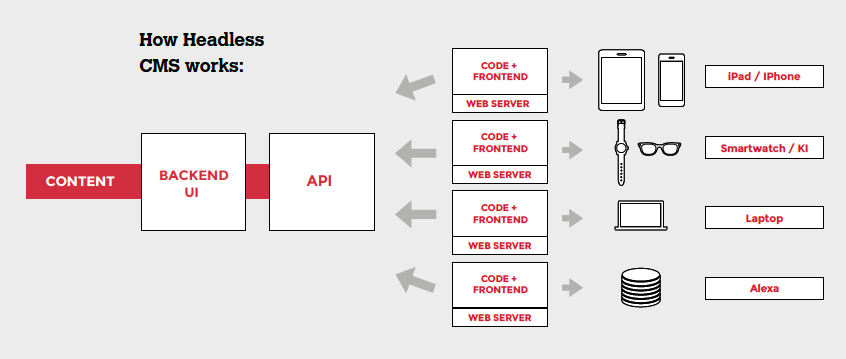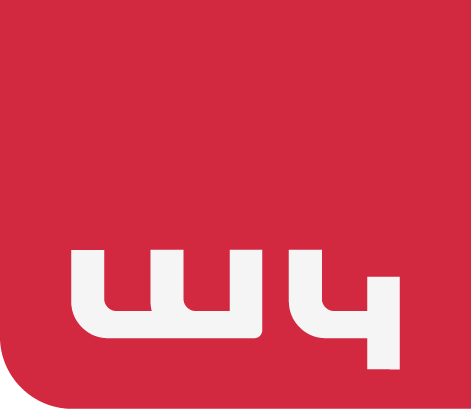No earlier than a few years ago, content management systems had the task of enabling copywriters to edit content via a backend and to store the content on a database. The stored data was displayed as a web page in the appropriate design via a created view in the frontend. Today, a website is only one of countless output formats for digital content. Responsive representations on the mobile, tablet or desktop marked only the beginning of a new era in which new media variations with special requirements to the output of the contents as well as the functions are added.
Table of contents
In these times, many contents of a website do not come directly from the Content Management System (CMS), but from various surrounding systems or systems of third parties. Companies use apps, language assistance systems or smartwatches as accompanying marketing instruments and offer users interesting additional functions that go beyond the classic output of texts and images. This requires various programming languages and structures that a classic CMS cannot provide. Web-App Developers have now found a solution to meet these new requirements. Equipped with a completely new IT architecture, modern headless content management systems ensure flexibility and offer the possibility of combining the best services for the preparation and presentation of content on the market (best of breed).
What is a Headless CMS?
Basically, a headless CMS is a central storage for content, which allows channel-neutral content management with options for editing and approval as well as subsequent publication in a connected output medium. At a headless content management system, the data is stored independently of the view. The system has suitable interfaces (API) which transfer the data from the database to flexible output media. In the figurative sense, the "face" is taken away from the CMS and it becomes "headless". The headless CMS therefore consists of a backend, a database and one or more APIs. The interfaces take over the function of the frontend (view, template). Compared to classic CMS, modern CMS are able to serve different programming languages across servers thanks to API. Headless does not have the restrictions with the functions as in the classic CMS.

A Headless CMS is basically a central repository for content.
Remember: The traditional CMS combines the four core areas: storage, administration, delivery and presentation of content. They are coupled in one product, which is why they are also referred to as "coupled" CMS. The headless CMS consists only of the storage of the contents and is connected with interfaces to the issuing media ("decoupled").
3 reasons to switch to Headless CMS
The best way to check whether investing in a decoupled content management system is the right next step is by looking at reasons that make a switch better than going on with a classic CMS. The more channels that are targeted in marketing, the more worthwhile it is to set up a headless CMS. There are further arguments against a traditional CMS and for a decoupled CMS.
1. Best of breed
Best of breed – connecting the best external services: When you are looking for possibilities with regular CMS with plugins and extensions to link non-system services to the CMS and still have to proceed quite restrictively, the API gives you enough freedom to choose the best micro service for your goals from the multitude of providers on the market and to connect it to the CMS. That can be other functions like the representation in the frontend, the personalization or options for the targeting. A connected microservice requires less programming effort, it reduces dependencies and also diminishes unwanted side effects within the entire system.
2. Ideal for 360° marketing
Free use of content – ideal for 360° marketing: With the separation of the backend from the view and the template engine, the restrictions known for classic CMS dissolve. The content can be played more easily on any device, any server and in any channels.
3. No content migration with system changes
Content migrations are no longer necessary – system changes do not generate any additional effort: the content is stored in the headless CMS separately from the frontend. Due to the decoupling, no content has to be migrated when there is a system change in the output, such as for websites or apps. This saves an enormous amount of time when switching to new systems.
You want to learn more on Headless CMS?
In our new W4 white paper "Headless CMS – more flexibility and efficiency for your content management system", we provide you with further reasons and advantages for converting from classic CMS such as Typo3 and WordPress.

Note: When discussing Headless CMS you should also check hybrid apps that combine the advantages of websites and native apps: progressive web apps (PWA). Why PWA are performing better at Google and are used by companies to gain and maintain customers is also explained in the white paper.







.jpg)


